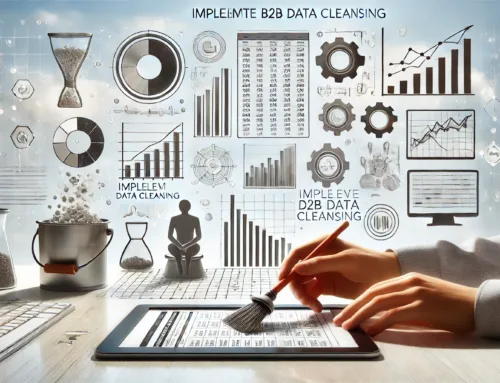To execute B2B data cleansing effectively, the key lies in a strategic and systematic approach. By understanding the nuances of your data, you can uncover hidden inefficiencies and inconsistencies that might be hindering your operations. But how do you navigate the complexities of data cleansing in a way that ensures lasting results? Let’s explore the essential steps and best practices that can transform your data quality and propel your business towards success.
Plan Cleansing Approach
When approaching the task of B2B data cleansing, it is essential to meticulously plan your cleansing approach. Data validation plays a crucial role in ensuring the accuracy and consistency of your data. By conducting thorough data validation processes, you can identify and correct any inaccuracies or inconsistencies present in your database. Additionally, data enrichment can enhance the quality of your data by adding valuable information from external sources.
Data profiling is another key aspect to consider when planning your data cleansing approach. By utilizing data profiling techniques, you can gain insights into the overall quality of your data, identify patterns, and detect anomalies. This information is vital for developing a targeted cleansing strategy that addresses specific data issues effectively.
Furthermore, data standardization is essential for maintaining uniformity and consistency across your database. Implementing standardized formats and conventions for data entry ensures that your information is structured in a coherent manner, facilitating easier data cleansing processes. In conclusion, by incorporating data validation, data enrichment, data profiling, and data standardization into your cleansing approach, you can optimize the quality and integrity of your B2B data.
Identify Data Issues
To successfully execute B2B data cleansing, the initial step involves identifying data issues that may compromise the accuracy and reliability of your database. Data profiling is a crucial technique in this phase, as it allows you to analyze the quality and condition of your data. By conducting data profiling, you can uncover inconsistencies, duplicates, missing values, and other anomalies that need to be addressed. This process provides valuable insights into the overall health of your database and helps in pinpointing areas that require immediate attention.
Error detection is another essential aspect of identifying data issues. Implementing robust error detection mechanisms enables you to flag erroneous data entries, such as incorrect formatting, outdated information, or invalid records. By detecting and documenting these errors, you can create a comprehensive list of data issues that need to be resolved during the cleansing process.
Execute Data Corrections
During the phase of executing data corrections in your B2B data cleansing process, you will implement targeted strategies to rectify identified data issues effectively. One crucial aspect of this phase is data validation, which involves systematically checking and verifying the accuracy and quality of the data. By conducting thorough data validation, you ensure that the corrections made are accurate and reliable.
Error detection plays a pivotal role in this process, as it helps in identifying discrepancies and inconsistencies within the data. It involves using various techniques such as data profiling, pattern matching, and outlier detection to pinpoint errors that need correction. Once errors are detected, you can then proceed to correct them by updating, deleting, or merging data records as necessary.
Verify Data Correctness
How can you ensure the accuracy and reliability of your data after executing corrections in the B2B data cleansing process? Data accuracy is crucial for making informed business decisions. To verify data correctness, a robust validation process is essential. Start by implementing data validation checks to identify any inconsistencies or errors. These checks can include ensuring data is in the correct format, validating against predefined rules, and cross-referencing with external sources.
Next, conduct thorough data profiling to understand the quality of your dataset. This involves analyzing the completeness, uniqueness, and consistency of the data. By identifying patterns and anomalies, you can pinpoint areas that require further attention. Additionally, consider using data quality tools to automate the validation process and streamline data verification tasks.
Regularly monitoring the data accuracy post-cleansing is vital. Set up alerts for potential errors or discrepancies and establish data quality KPIs to track improvements over time. By continuously refining your validation process, you can maintain high data accuracy levels and ensure the reliability of your business data.
Monitor Data Quality
Monitoring data quality is a critical aspect of ensuring the ongoing accuracy and reliability of your business data. To effectively monitor the quality of your data, consider the following data monitoring techniques and quality control strategies:
- Automated Alerts: Implement automated alerts that notify you of any anomalies or discrepancies in your data. Set up triggers to flag potential errors or inconsistencies in real-time, allowing you to address issues promptly.
- Regular Audits: Conduct regular data audits to assess the overall quality and integrity of your data. Establish a schedule for comprehensive reviews to identify patterns of inaccuracies or outdated information that may impact decision-making processes.
- Performance Metrics: Define key performance metrics related to data quality and track them consistently. Measure factors such as data completeness, accuracy, and timeliness to gauge the effectiveness of your data cleansing efforts and ensure continuous improvement.
Frequently Asked Questions
How Can I Prevent Data Quality Issues From Recurring in the Future?
To prevent data quality issues from recurring, ensure consistent data validation processes are in place. Regularly review and update data enrichment strategies. Implement automated checks and balance mechanisms to maintain data accuracy and reliability over time.
What Tools or Software Can I Use for Large-Scale Data Cleansing?
For large-scale data cleansing, tools like data validation and data enrichment software are essential. These tools can streamline the process, ensuring accuracy and completeness of your database, leading to more effective decision-making and improved business outcomes.
Is It Necessary to Involve All Departments in the Data Cleansing Process?
Involving all departments in the data cleansing process ensures departmental buy-in and fosters cross-functional collaboration. This approach promotes data accuracy, enhances communication across teams, and leads to more comprehensive and effective data cleansing outcomes.
Can Data Cleansing Improve Our Company’s Overall Operational Efficiency?
Improving data accuracy through cleansing can significantly enhance operational efficiency by streamlining processes, reducing errors, and enabling better decision-making. This ultimately leads to cost reduction, increased productivity, and a competitive edge in the market.
How Often Should Data Cleansing Be Conducted for Optimal Results?
For optimal results, you should conduct data cleansing regularly. Frequency recommendations vary but best practices suggest performing this task quarterly or semi-annually. Consistent maintenance ensures accuracy, efficiency, and maximum value from your B2B database.




